What are the leading causes of death in the UK?
Yesterday, Full Fact looked into the reporting of drink driving statistics and how they are reported to have changed over time. Following this, a reader contacted us for information on what the main causes of death are in the UK.
Full Fact decided to look into the figures.
Analysis
The ONS publishes annual statistics on mortality which provide a vital insight into the most common causes of death in the UK. The most recent statistics published at the beginning of 2011 are for 2009.
The top ten causes of death are set out in the table below and show the key differences between causes for men and women.
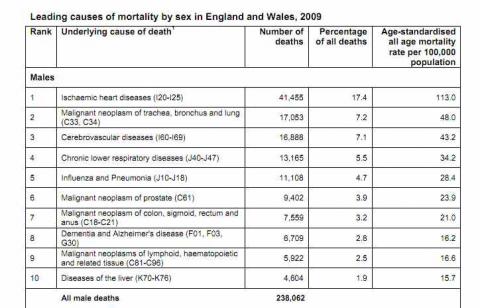
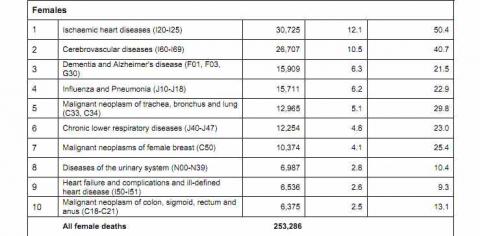
The tables reveal some interesting differences between the main causes of death for men and for women, for instance that Dementia and Alzheimer's disease accounts for over six per cent of all female deaths compared with just under three per cent of male deaths.
The major causes of death in females are also more evenly spread as a percentage of total female deaths (with a jump of less than two per cent from the second to first causes) whereas males are much more likely to die of Ischaemic heart disease than any other cause (a jump of more than ten per cent).
The charts below show the main causes of death in 2009 (pink) compared with the main causes in 2004 (blue).
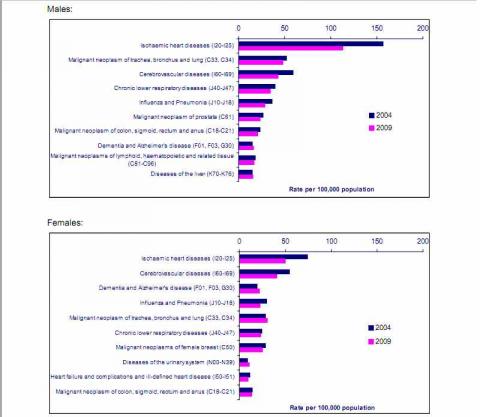
For most causes of death, the number people of dying has fallen since 2004. However in both men and women the number of people dying from Dementia and Alzheimer's disease increased in the five years to 2009. Female deaths due to lung cancer and urinary diseases have also seen an increase and male deaths due to liver disease have also increased.
The table below shows that ten leading causes of death worldwide in 2008 and is published by the WHO.
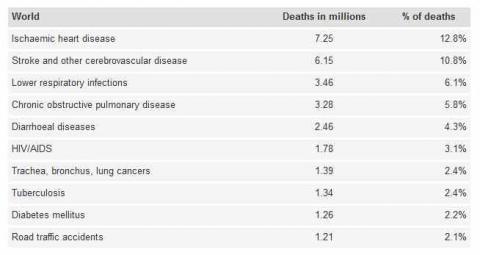
The causes which appear on the world list which are not present on the UK top ten include TB, HIV/AIDS and road traffic accidents. Ischaemic heart disease tops both lists, accounting for nearly 13 per cent of deaths worldwide.
The WHO claims that tobacco is a major contributor to many of the leading causes of death including cardiovascular disease, chronic obstructive lung disease and lung cancer. As such, they state that in 2008, smoking was responsible for one in ten deaths worldwide.
The ONS also has statistics on all causes of death; of particular relevance to yesterday's statistics on drink-driving is the data on deaths caused by transport accidents. The data shows that in 2009, 2,284 people were killed in accidents involving transport, with males accounting for 77 per cent of those deaths.
The Department for Transport publishes data on the estimated number of deaths caused annually by drink-driving. It is important to note that these figures are estimates and the figures for 2009 are provisional estimates.
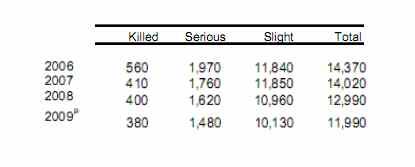
The figures show that the number of people killed due to drink-driving accidents (estimated at 380 in 2009) has decreased in recent years and has decreased considerably since 1979 when the figure was 1,640.
Conclusion
The figures from the ONS show that there are marked differences between the leading causes of death for men and women, although heart disease is still the biggest killer in the UK and the world as a whole. Smoking, which is one of the contributory factors of lung and heart diseases, is responsible for one in ten deaths worldwide according to the WHO.
The main cases of death have continued to fall in the last five years, with a few marked exceptions, including the rates of Alzheimer's and Dementia in both men and women.
The numbers killed in drink-driving related accidents are also decreasing following greater media coverage and targeted campaigning to reduce drink-driving in general.